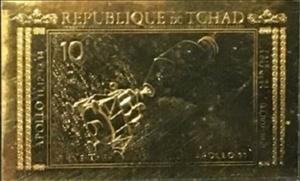Stamp: Apollo XI (Chad 1971)
Apollo XI (Chad 1971)
05 July (Chad ) within release Space Exploration goes into circulation Stamp Apollo XI face value 10 Central African CFA franc
| Stamp Apollo XI in catalogues | |
|---|---|
| Michel: | Mi: TD 387B |
Stamp is square format.
Also in the issue Space Exploration:
- Souvenir Sheet - Apollo 11 - Apollo 14 face value 10;
- Stamp - Apollo XI face value 10;
- Stamp - Apollo XI face value 10;
Stamp Apollo XI it reflects the thematic directions:
The Moon is Earth's only natural satellite. It orbits at an average distance of 384,400 km (238,900 mi), about 30 times the diameter of Earth. Tidal forces between Earth and the Moon have over time synchronized the Moon's orbital period (lunar month) with its rotation period (lunar day) at 29.5 Earth days, causing the same side of the Moon to always face Earth. The Moon's gravitational pull – and to a lesser extent, the Sun's – are the main drivers of Earth's tides.
Outer space (or simply space) is the expanse that exists beyond Earth's atmosphere and between celestial bodies. It contains ultra-low levels of particle densities, constituting a near-perfect vacuum of predominantly hydrogen and helium plasma, permeated by electromagnetic radiation, cosmic rays, neutrinos, magnetic fields and dust. The baseline temperature of outer space, as set by the background radiation from the Big Bang, is 2.7 kelvins (−270 °C; −455 °F)
A spacecraft is a vehicle that is designed to fly and operate in outer space. Spacecraft are used for a variety of purposes, including communications, Earth observation, meteorology, navigation, space colonization, planetary exploration, and transportation of humans and cargo. All spacecraft except single-stage-to-orbit vehicles cannot get into space on their own, and require a launch vehicle (carrier rocket).




